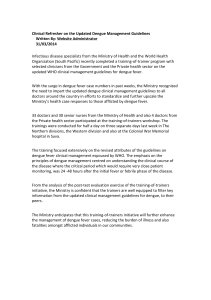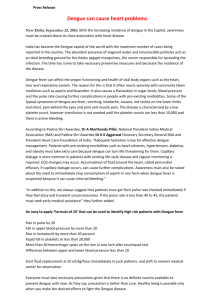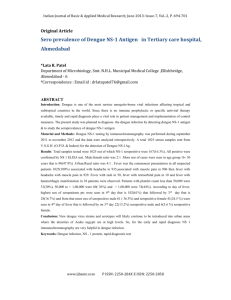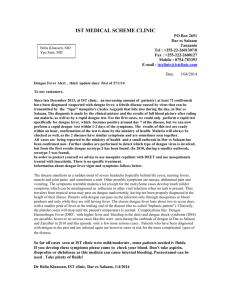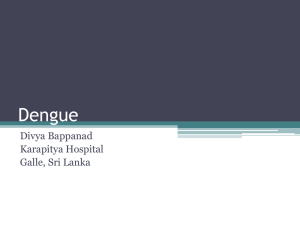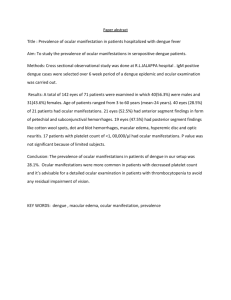INTRODUCTION: Bilateral intra-retinal macular hemorrhage alone is
advertisement
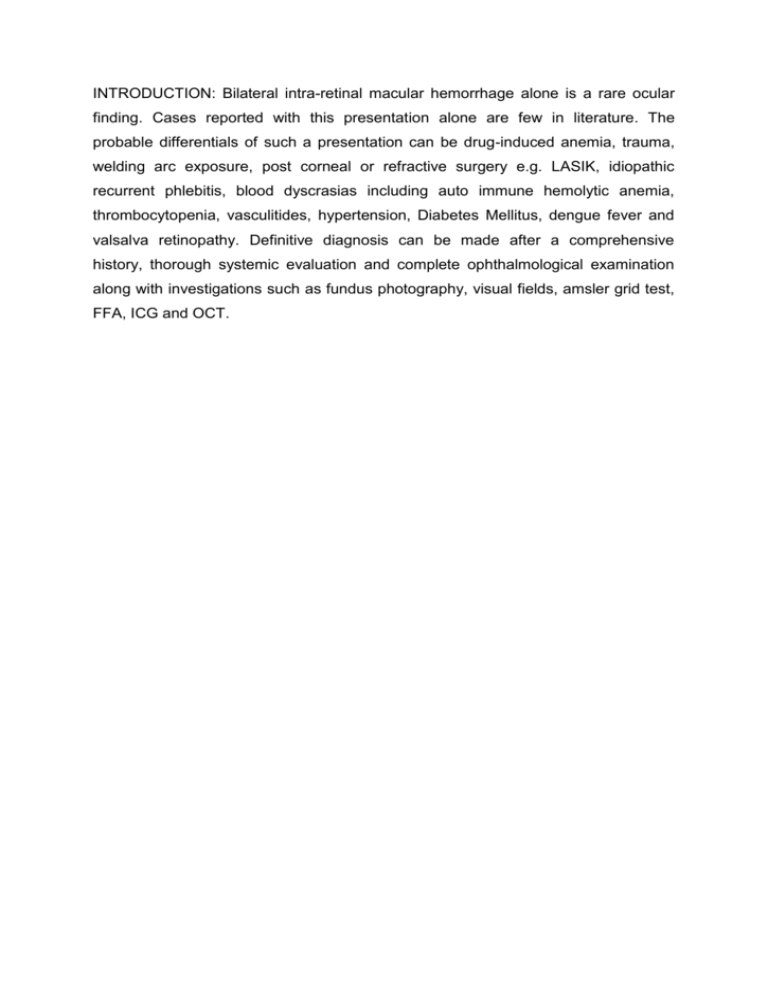
INTRODUCTION: Bilateral intra-retinal macular hemorrhage alone is a rare ocular finding. Cases reported with this presentation alone are few in literature. The probable differentials of such a presentation can be drug-induced anemia, trauma, welding arc exposure, post corneal or refractive surgery e.g. LASIK, idiopathic recurrent phlebitis, blood dyscrasias including auto immune hemolytic anemia, thrombocytopenia, vasculitides, hypertension, Diabetes Mellitus, dengue fever and valsalva retinopathy. Definitive diagnosis can be made after a comprehensive history, thorough systemic evaluation and complete ophthalmological examination along with investigations such as fundus photography, visual fields, amsler grid test, FFA, ICG and OCT. CASE REPORT: A 25 year old female from a village in Amritsar district, housewife and a mother of two, with no history of any prior ocular complaints presented at the Regional Institute of Ophthalmology, Amritsar OPD with the complaint of sudden painless bilateral blurring of vision. There was no history of fever, diarrhoea, vomiting, any head or ocular trauma. There was no history of any systemic affliction like diabetes, hypertension, any vasculitides, blood dyscrasias, blood transfusions, any ocular surgical intervention or drug intake. History of present illness: Patient complained of blurring of vision in both eyes since 24 hours before which patient was apparently asymptomatic. On general examination patient was calm, cooperative and conscious. Vitals: Blood Pressure: 120/74 mm of Hg, Pulse: 70/minute, Afebrile. • VA: 6/36 partial OD and 6/60 partial OS • No improvement with pin hole • Near Vision: N12 partial OU • Pupillary responses and intraocular pressure were normal • Anterior segment WNL • Fundus examination showed the following picture: FUNDUS PICTURE OD: MACULAR HAEMORRHAGE FUNDUS PICTURE OS: MACULAR HAEMORRHAGE OCT OF PATIENT OCT OD OCT OU showed intraretinal macular haemorrhages. OCT OU Patient was advised to instill NSAID eye drops and prescribed oral antioxidants till other reports were awaited. Systemic investigations were within normal limits except for a low platelet count (1,00, 000/mm3). On the basis of clinical suspicion and a low seemingly low platelet count, we advised the patient dengue serology- which came out positive- which came out POSITIVE. Patient was treated and managed for dengue in Guru Nanak Dev Hospital and was followed up in the Ophthalmology Out-patient department. Conservative treatment was continued for her ophthalmic complaints and follow up included repeat OCT and HVF. Patient’s visual acuity improved to 6/12 partial OU on follow up after two months, OCT also showed improvement and resolution of the haemorrhage. TWO MONTHS POST EPISODE IMPROVEMENT SEEN ON OCT POST TWO MONTHS OF CONSERVATIVE TREATMENT OD HVF 24-2 shows resolution two months post-episode SCOTOMA SEEN ON HVF 24-2 TWO MONTHS AFTER THE EPISODE (OS) DISCUSSION Dengue fever, the most common mosquito borne viral disease in humans is a multi-systemic disease with known ocular complications.The typical patient is a young immunocompetent individual with a history of travel to, or residence in an endemic area, who presents with visual blurring or paracentral scotoma on days 5 to 7 after onset of fever coinciding with the nadir of thrombocytopenia. Dengue maculopathy which could be caused by vascular alterations and/or aberrant immune response after infection may result in temporary or permanent visual losses. Dengue fever can lead to visual impairment in the form of blurring of vision (most common), central scotoma, micropsia/metamorphosia, floaters, visual field defect, near vision disturbance, impairment of colour vision, ocular pain and redness visual field defect, detectable by ophthalmological exams such as angiography, retinography, and OCT imaging, as well as retinal and cortical electrophysiology.The Snellen Visual Acuity varies from 6/6 to counting fingers only (median 6/12) and is maculopathy dependent. A significant improvement in mean BCVA from baseline is noted between weeks 2 and 4 and may take upto three months. Although visual acuity continues to improve thereafter, the difference between subsequent follow-up intervals is less significant. Ocular complications involving the anterior segment of the eye include subconjunctival haemorrhage, anterior uveitis and dengue-related shallow anterior chamber. Ocular complications of the posterior segment of the eye are most commonly found on the macular region. Dengue maculopathy has myriad manifestations: inflammatory and occlusive or both. Macular hemorrhage and oedema make up the majority of the findings. Ocular symptoms manifest at or close to the trough of the serum platelets and leucocytes level as well as 5 to 7 days from the onset of dengue fever. This parallels the proposed immune-mediated inflammatory mechanism of dengue maculopathy. Another mechanism proposed is the thrombocytopenic state resulting in bleeding tendencies and retinal haemorrhages. Teoh et al observed that the onset of manifestations coinciding with the start of thrombocytopenia recovery correlates with increased immunological response, hence supporting the immune medicated mechanism of pathogenesis. Hemorrhages associated with dengue-related maculopathy are mostly intraretinal and can take the form of dot, blot, or flame-shaped hemorrhages. Ophthalmic investigations are performed mostly for posterior segment pathology and include visual acuity, slit-lamp examination, dilated fundus examination, visual fields, Amsler Grid test, FFA, ICG and OCT. Prognosis is generally good as the disease is often self-limiting, resolving spontaneously even without treatment. Patients may experience mild relative central scotoma that may persist for months. The use of steroids in treating this inflammatory eye condition is controversial. In conclusion, a high index of suspicion is necessary in cases reported in endemic areas and in people with a recent history of travel to the same in order to diagnose Dengue as a cause of ophthalmic manifestations. REFERENCES 1. Bascal KE, Chee SP, Cheng C-Li, Flores JVP. Dengue-associated maculopathy. Arch Ophthal. 2007;125:501-510. 2. Young SM, Santiago P, Chee CKL. A Patient Presenting with Bilateral Central Scotomas after Dengue Fever. World J Retina Vitreous 2012;2(1):18-21. 3. Teoh SCB, Chan DPL, Nah GKM, Rajagopalan R, Laude A, Ang B et al. The Eye Institute Dengue-related Ophthalmic Complication Workgroup. A re-look at ocular complications in Dengue fever and Dengue haemorrhagic fever. Dengue Bulletin 2006,(30):184-90. 4. Chlebicki MP, Ang B, Barkham T, Laude A. Retinal hemorrhages in four patients with dengue fever. Emerg.Infect Dis. 2005, May;11(5):770-2.
